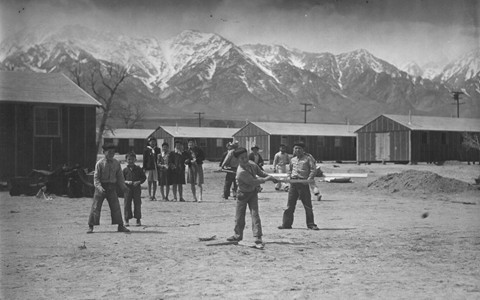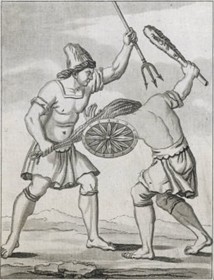Cramming on a Wired deadline this afternoon, so we’ll outro with yet another track that the essential WEFUNK recently turned us on to. The group itself, Strictly Roots, is mighty obscure—as far as we can tell, they released just one album, back in 1993, before vanishing into the ether. But they were big enough to convince Fat Joe and Grand Puba to appear on this song, so they apparently had quite a bit going for them during their brief golden age. Of course, this was back before Fat Joe’s waistline really expanded to McCrary Twins dimensions—a more anatomically accurate handle for him back then would’ve been Portly Joe.
Beg No Friends
July 21st, 2009
Comments Off on Beg No FriendsTags:Fat Joe·Grand Puba·hip-hop·McCrary Twins·music·Strictly Roots·WEFUNK
Wait of the World
July 21st, 2009
Account of Ajmal Kasab’s surprise confession have often noted that the Mumbai attacker’s trial has proceeded at a lightning clip, at least compared to other Indian criminal proceedings. How quickly have things gone? A 2007 study in Delhi cast a harsh light on the nation’s creaky wheels of justice:
The analysis is based upon the cases listed before all the 135 criminal courts of the city on a one particular typical day, selected at random. The study finds that in the sessions courts the overwhelming majority of cases carrying 2006 as the year of commission of offence had been pending for more than a year. Specifically, it shows that approximately 67 per cent of the pending criminal trials are one to five years old, 12 per cent six to ten years old, 4 per cent 11-15 years old, and around 2 per cent pending for more than 15 years. On the date selected a mere 14.15 per cent of the matters had come up for trial in the same year as the crime allegedly occurred. Similarly, the courts of the Metropolitan Magistrate also have matters pending trial for offences registered more than 19 years ago.
(Our bolding.) For the Americans in the audience, be extra thankful for the Sixth Amendment and that underrated right to a speedy trial.
Comments Off on Wait of the WorldTags:Ajmal Kasab·crime·India·law·terrorism
The Flag Racket
July 21st, 2009
 Once again, we’re gonna use our platform here to highly recommend The Snakehead, Patrick Radden Keefe’s non-fiction account of the 1993 Golden Venture disaster. The book would be awesome enough if it just told the tale of Sister Ping‘s rise and fall as the tsarina of human smuggling in New York’s Chinatown. But The Snakehead offers a whole lot more—it’s chock full of knowledge-expanding goodness, touching on everything from FBI informant policies to the Kenyan restaurant scene. And then there’s this excellent explainer on the origins of the flags-of-convenience scam, by which substandard boats are permitted to roam the oceans under the aegis of Panama, Liberia, or landlocked Mongolia:
Once again, we’re gonna use our platform here to highly recommend The Snakehead, Patrick Radden Keefe’s non-fiction account of the 1993 Golden Venture disaster. The book would be awesome enough if it just told the tale of Sister Ping‘s rise and fall as the tsarina of human smuggling in New York’s Chinatown. But The Snakehead offers a whole lot more—it’s chock full of knowledge-expanding goodness, touching on everything from FBI informant policies to the Kenyan restaurant scene. And then there’s this excellent explainer on the origins of the flags-of-convenience scam, by which substandard boats are permitted to roam the oceans under the aegis of Panama, Liberia, or landlocked Mongolia:
Until the early twentieth century, there was generally some correlation between the home port or ownership of an oceangoing vessel and the nationality of the flag that it flew. But during Prohibition the American owners of two cruise ships, frustrated that they could not serve alcohol on board, were permitted to reregister their ships in Panama, despite the fact that neither the companies nor their ships, nor the routes that those ships took, had any special relationship with the Central American country. When, on December 5, 1922, the ships lowered their U.S. flags and raised the red, white, and blue flag of Panama, they ushered in a phenomenon that would become known as “flags of convenience.”
The Golden Venture was a perfect case in point: an aging, rust-corroded freighter that was doing nothing more than shuttling goods between Vietnam and Cambodia when it was called upon to take 300-plus Fujianese immigrants across the Atlantic Ocean. And it made that long, perilous journey under the flag of Honduras.
Check out a great backgrounder on the numerous downsides of flags-of-convenience here (PDF). Panama is still the world leader, by a country mile.
Comments Off on The Flag RacketTags:China·crime·Golden Venture·immigration·law·Liberia·maritime·Mongolia·Panama·Patrick Radden Keefe·Sister Ping·The Snakehead
Animal Could Have Done It
July 20th, 2009
Tending to Microkhan Jr. has given us a newfound appreciation for great kiddie fare of yore, most notably the late, great Muppet empire. And do when we stumbled across this clip of various Henson creations “auditioning” for the role of Yoda, we couldn’t resist the urge to pass it along. Honestly, we could totally see Animal tackling the role—especially in those lightsaber fight scenes. His technique would probably be very Drunken Master-ish.
→ 2 CommentsTags:Drunken Master·martial arts·Muppets·parenting·Star Wars·TV·Yoda
Fatally Besotted
July 20th, 2009
Upon reading this tragic yet all-too-common tale from this morning’s New York Times, we were reminded of our long-held hypothesis that a huge number of homicides would never occur were it not for the ingestion of alcohol. Yet we’ve never really had a good sense of what percentage of killings involve inebriated parties—at least until we read this recent paper from the Australian Institute of Criminology:
The current study sought to build on the limited Australian research on alcohol-related homicide by examining solved homicides recorded in the National Homicide Monitoring Program over a six year period. Of the 1,565 homicides, nearly half (47%) of the incidents were classified as alcohol related and of those, over half involved both the victim and offender consuming alcohol prior to the incident.
The paper’s two tables are fascinating, especially the one that breaks down the analyzed homicides by date, time, and place. The most dangerous place to drink? In your very own home, between 6 p.m. and midnight on a weekend night, with friends. And if you’re unemployed, you’re twice as likely to be the victim of a homicide than one of your working peers.
The looming question, of course, is how to reduce the number of such homicides—a tough assignment, given that so many of the violent incidents take place in private quarters. We’ll surely be exploring some possible solutions in future posts, so please keep an eye peeled.
And please note that Microkhan is a devoted aficionado of hops, the grape, and distilled spirits, and so is not proposing any kind of prohibition. As we’ve stated before, we blanch at the thought of living in a dry town.
→ 10 CommentsTags:alcohol·Australia·beer·crime·research·wine
The Lunar Also-Ran
July 20th, 2009
 As we spend today celebrating the 30th anniversary of mankind’s first visit to the Moon, it’s worth noting that America’s space-race triumph was far from pre-ordained. In fact, the smart money circa 1963 would have been on the Soviets reaching the goal first, due to the seldom recognized genius of Sergei Korolev. The man responsible for such feats as Laika’s orbiting and the underrated Venera 3 mission, Korolev once seemed well on his way to getting a Russian to alight on the Moon before NASA got its act together. But the Soviets’ lack of teamwork helped doom his dreams:
As we spend today celebrating the 30th anniversary of mankind’s first visit to the Moon, it’s worth noting that America’s space-race triumph was far from pre-ordained. In fact, the smart money circa 1963 would have been on the Soviets reaching the goal first, due to the seldom recognized genius of Sergei Korolev. The man responsible for such feats as Laika’s orbiting and the underrated Venera 3 mission, Korolev once seemed well on his way to getting a Russian to alight on the Moon before NASA got its act together. But the Soviets’ lack of teamwork helped doom his dreams:
[Korolev] had to deal with competition from rival designers—Valentin Glushko, the rocket engine designer who had defected from Korolev’s team to join Vladimir Chelomei; and another team headed by his former colleague, Mikhail Yangel. Glushko had refused to design the oxygen–kerosene engines that Korolev preferred and so another engine firm, experienced mostly with aircraft engines, had to be relied on.
The subsequent design called for 24 engines in the first stage, later expanded to 30 when it became clear that the vehicle would be unable to lift the huge lunar payload, laden with bulky, relatively primitive electronics. With constant opposition from the tunnel–visioned military, preoccupied with weapons, he never got the funds to statictest his engines as a system, and this failure would prove fatal.
The whole Korolev history is highly recommended, if only to marvel at his transition from gulag inmate to father of the Soviet space program. His legacy lives on in the engineering corporation that bears his name, and which is heavily involved with the maintenance of the International Space Station.
Comments Off on The Lunar Also-RanTags:1960s·Laika·Moon·NASA·Russia·satellites·Sergei Korolev·Soviet Union·Venus
One at a Time, Please
July 17th, 2009
This week’s installment of Bad Movie Friday brings us some serious high-concept nonsense: the 1985 Kurt Thomas vehicle Gymkata, which sought to cash in on the nation’s post-Mary Lou Retton love affair with gymnastics. And what better way than to take a slightly past-his-prime male gymnast and insert him into a limp ninja flick?
We understand that Gymkata has its share of fans, though most are likely of the ironic variety—the same crew that has raised the equally ridiculous (yet enjoyable) Roadhouse to great height of pop-cult celebration. Perhaps we’re missing something, but c’mon—how can you love an action movie that includes that most irritating of cinematic clichés, the army of axe-wielding henchmen who politely decided to attack one-at-a-time? If those toothless villagers had any sense at all, Thomas would have been lying dead at their feet within a matter of seconds. Maybe they were just too dazzled by his fluid moves on the conveniently located pommel horse. Because, obviously, every backwater Moldovan town has a pommel horse in the main square, right?
→ 7 CommentsTags:Bad Movie Friday·Gymkata·gymnastics·Kurt Thomas·martial arts·Mary Lou Retton·movies·sports
Goons Never Go Out of Style
July 17th, 2009

A recent rash of moonshine deaths in Gujarat got us thinking about the state’s failed prohibition policy (PDF). While liquor bans may have some discernible impact in isolated villages, they’re doomed to failure in larger regions that are tied to wet neighbors via modern highways. But the black market for legit liquor is only for the moderately well-off; the poor must make do with bootleg hooch, which all-too-often is spiked with lethal amounts of methanol.
Yet Gujarat’s prohibition still enjoys broad support from politicians—though not necessarily because they’re pandering to the morals crowd. As this excellent slideshow on Indian political thuggery makes clear, politicians enjoy being able to bribe poor voters with bottles of whiskey. Were prohibition to fall by the wayside, their bribes would lose some value. And so the dangerous charade continues.
Comments Off on Goons Never Go Out of StyleTags:alcohol·crime·Gujarat·India·law·politics·Prohibition
Goes Down Smooth as Fire
July 16th, 2009
Anyone who’s ever sampled Thunderbird is unlikely to forget the experience—or, for that matter, to recall it with much fondness. The stuff is the very epitome of bum wine, heavy on the alcohol and the commensurate taste of metallic burning. This detailed review breaks it down for the broke oenophiles in the audience:
For all the legend and hype surrounding this booze and its Clorox-like qualities, Thunderbird wasn’t nearly as harsh as I was expecting. It retained a flavor of poorly fermented grapes and, aside from the burning and industrial-strength smell, actually tasted like a really, really, really awful white wine. It was intensely sugary and presented an aftertaste that fell somewhere between ginger ale and cough syrup.
And yet when Thunderbird first hit the market, Ernest and Julio Gallo thought they had a classy drink on their hands—classy enough to hire British actor James Mason as their spokesperson. We’re rather curious how the Gallos eventually figured out that Thunderbird was not welcome in Eisenhower-era suburban liquor cabinets, and that they were better off reinventing the brand as the alcoholic equivalent of private-label mac-‘n-cheese.
(h/t SlarkPope)
Doin’ It All for Xbalanque
July 16th, 2009
 Though the practice of seppuku is virtually synonmous with ritual suicide, it’s worth noting that feudal Japan hardly had a monopoly on ceremonial self-slaughter. The Mayans were also enthusiasts, though the details of their process obviously differed from those of their peers across the Pacific. As this fascinating paper makes clear, the Mayan method involved the severing of one’s carotid artery with an axe or knife, then dancing until Death came knocking.
Though the practice of seppuku is virtually synonmous with ritual suicide, it’s worth noting that feudal Japan hardly had a monopoly on ceremonial self-slaughter. The Mayans were also enthusiasts, though the details of their process obviously differed from those of their peers across the Pacific. As this fascinating paper makes clear, the Mayan method involved the severing of one’s carotid artery with an axe or knife, then dancing until Death came knocking.
At least that was the ritual in its purest form. Yet not all participants perished—or, for that matter, were willing. The victims, the paper’s authors argue, fell into one of three distinct categories:
Firstly there are those who completely severed their carotis thus committing an act of suicide on their own free will. The ch’akba dancers on the vase from the Museo Popol Vuh and on the Robicsek and Hales vase belong to this group.
Secondly there are those who offered blood from their carotis but did not die because precautionary measures were taken, i.e. the carotis was only slightly opened and ek’ balam [a medicinal shrub—ed.] was applied. K’an Hok’ Kitam II of Palenque and the dancer on the Kerr vessel belong to this group.
Thirdly there are those who were forced to offer blood from their carotis but were denied the necessary aid. So they died in an act of imposed suicide. Waxakiahun u Bah K’awil of Copan and Pat Buts’ K’awil of Seibal belong to this group.
When the ritual was performed for genuinely religious reasons, it was done to mimic the Phoenix-like death and resurrection of the deities Hunahpu and Xbalanque. (True, the human participant never quite got to the “resurrection” part of the equation—details, details.) But we get the feeling that some cruel Mayan nobles simply used the ceremony as an excuse to dispatch with rivals, captives, and disobedient household servants. Judging by the paper’s language, we can even see how victims were conned into slicing: “Sure, go ahead and cut—I’ll be right here with the ek’balam when you’re done. Trust me.”
The Final Word on Cloud Seeding?
July 16th, 2009
India’s making a big, expensive stab at determining once-and-for-all whether man can make it rain. (No, not in the figurative sense.) Color us a little skeptical; we’ve always thought that positive cloud-seeding results were often due more to luck than the effects of sprinkled silver iodide. (For the umpteenth time, people, correlation is not causation.) And this recent Scientific American interview with an American cloud-seeding expert doesn’t do much to allay our suspicions. Note the man’s cautious hedging throughout:
What are the best results you can hope for with cloud seeding?
It depends on where you are, and the reasoning behind it. If you’re trying to increase rain or snowfall for the water supply, a 10 percent addition could do a lot. If you had a large basin like I work with, between 300,000 and 500,000 acre-feet, a 10 percent increase would equal 30,000 to 50,000 more acre-feet of water. If you can do that, it’s very economically sound.Can you attribute any one storm to cloud seeding?
Generally, you can’t look at one individual storm. Would it have snowed anyway? You don’t know. NCAR (the National Center for Atmospheric Research in Boulder, Colo.) is in Wyoming studying several seasons in comparison, where you seed one place and withhold another. Attributing one storm to seeding is very difficult unless the cloud system is incredibly simple, like fog that has no chance of precipitation. If you see snowfall then, that’s pretty demonstrative evidence that you succeeded.
Still, Malaysia evidently buys into the technology, as an anti-wildfire measure. Best of luck to them.
The Eyes of Ms. T.J. Eckleburg Diaz
July 15th, 2009

We recently stumbled across the photo above while sifting through the National Archives “Picturing the Century” website, in search of images of child coal miners. Something about the two girls’ sharply differing expressions stuck with us—the one on the left strikes us as the contemplative member of the duo, the one on the right the impulsive hellraiser. The caption, alas, provides little background as to who these girls were, or how they ended up gazing into the lens:
Two Latin girls pose in front of a wall of graffiti in Lynch Park in Brooklyn, New York City, June 1974.
The photographer was the great Danny Lyon, recently the subject of an info-rich NYT paean. Check out some of his more recent work here; we’re especially big fans of his multiyear series from Indian Country.
Comments Off on The Eyes of Ms. T.J. Eckleburg DiazTags:Danny Lyon·New York City·photography
The Mysterious Mr. Mason
July 15th, 2009
Talk about one-hit wonders: the above tune, famously sampled in a couple of hip-hop gems, appears to be the only single ever churned out by Lee Mason & His Orchestra. The group is so obscure, in fact, that it’s often not even credited with “Shady Blues”; the song was apparently re-released in the U.K. under the name Pete Moore, and it’s Moore who usually receives the credit on soul compilations. But the genius here is actually all Mason’s, right down to the flute solo.
We’ll follow up soon with a couple of posts on contemporary cuts that rely on Mason’s lazy groove. The man deserves far more recognition than he’s received, if only for this one classic.
Poison on the March
July 15th, 2009

A loyal reader recently sent us the above graph, culled from a recent issue of Morbidity and Mortality Weekly Report. The accompanying text only explains what’s obvious to even the untrained eye: as the age-adjusted death rates linked to firearms and motor-vehicle accidents have declined, poison has become an increasingly efficient killer of Americans.
Does this mean our nation’s children are becoming more proficient at opening kitchen cabinets and getting at the cleaning supplies? Not at all—the Centers for Disease Control includes prescription drug overdoses among its poisoning statistics. And those overdoses constitute the vast majority of today’s cases of death-by-poison:
More than 23,000 unintentional poisoning deaths occurred in the United States in 2005. Almost all of them were due to drugs.
(Our bolding.) While about half of calls to poison-control centers involve concerns over children’s ingestion of chemicals, such incidents lead to relatively few fatalities—in part, of course, because the centers help the most severely affected victims obtain critical medical assistance. But adults who’ve taken too many pills? They’re less likely to call, perhaps because of their impaired judgment. And so, unlike with injuries due to firearms or traffic accidents, many poisoning victims never receive care until it’s too late.
The more important story here, however, is our increasing reliance on prescription drugs. Check out the stats here (PDF); the percent of Americans taking at least one medication per month increased by 19.4 percent between 1988 and 2004. And the number of heavy users—that is, people taking three or more prescriptions per month—nearly doubled over that same time span. Small wonder, then, that overdoses have increased—even the most beneficial medicines can do grave harm if taken in large quantities. Which is probably a good reason for physicians to be a wee bit more cautious when doling out the pills—something that’s unlikely to happen in our current FUBAR health-care system, in which writing scripts is often the quickest, cheapest way to dispense with bothersome patients.
Comments Off on Poison on the MarchTags:drugs·medicine·poison·public health
The King of Guyana, via The Cleve
July 14th, 2009
Today marks the 30th anniversary of the murder of Father Bernard Darke, a Jesuit priest who worked as a photographer for a Catholic newspaper in Guyana. Darke was beaten to death while snapping pictures of an anti-government protest. His assailants were all members of one of the most curious quasi-religious groups to ever grace the Western Hemisphere: the House of Israel, a black supremacist cult that doubled as a paramilitary in the service of Guyanese President Forbes Burnham.
The House of Israel was essentially the religious fiefdom of an American who was given the name David Hill at birth, but later changed his moniker to the more impressive Rabbi Edward Washington. The tale of how he became Burnham’s muscle is told in this 1984 AP piece:
Washington said he came to Guyana in 1972, after stops in Algeria, Haiti and Cuba, to escape serving prison sentences in Ohio. Cleveland court records show Washington had been convicted of nine counts of blackmail in connection with a boyctt which forced several white-managed McDonald’s fast food franchises in Cleveland to be sold to blacks.
In Guyana, Washington has a private home beside the Carribbean, a rambling, well-furnished, single-story house with a swimming pool. Handwritten labels are tacked to two lounge chairs in the dining room. One says “the king,” the other “the queen.” Washington refers to his Guyanese wife and three children as the royal family.
“Everbody that’s wantin’ is gettin’ now, and that’s my religion,” he said. “I don’t believe in no milk and honey in heaven…I want now. I want land. I want it now. I’m trying to get some more. I want milk and honey. So I buy cows, we get some milk and we get beehives and we get some honey, right now, here on this Earth.”
After his presidential protector died, however, Washington found himself less able to reap milk and honey in Guyana. Details of his post-Burnham comedown can be found in his 2005 obituary.
→ 4 CommentsTags:cults·Guyana·House of Israel·Rabbi Edward Washington·religion
Airplanes Out to Pasture
July 14th, 2009

Depression v2.0 may be rough all around, but that doesn’t mean there aren’t more than a few economic winners amidst the widespread misery. You already knew about foreclosure specialists and pawn shops; now cast your jealous gaze toward the folks who operate commercial airplane graveyards, where flailing carriers are stashing the aging jets they can no longer afford to keep aloft. And judging by the stats, airlines are far more eager to cast off Airbus models than Boeings—perhaps because of Euro-planes higher maintenance costs:
While Boeing planes may account for 72 per cent of parked aircraft at the end of June 2009, only 11 per cent of those Boeing planes are models still in production (i.e. reasonably new), according to UBS. In contrast about 60 per cent of parked Airbus aircraft are in-production ones. Ouch.
We were initially a bit puzzled as to why airlines keep around out-of-production aircraft at all. But then it dawned on us—rather than sell the planes for scrap and take a medium-sized loss, carriers are gambling that they’ll someday be able to peddle their “junkers” to airlines in the developing world. Which, of course, can lead to some inevitable safety problems (PDF) down the line.
→ 11 CommentsTags:Airbus·aviation·Boeing·Depression v2.0·economics
“Dim the Lights and Turn Up the Jodeci”
July 13th, 2009
Been meaning to post this Lost Boyz classic for ages, but it took the invention of the Grooveshark widget to provide the necessary technological push. We were definitely latecomers to this whole album, and for years our fandom extended only as far as the remixed version of “The Yearn” (which we actually scooped up on a Pete Rock compilation). But the cut above came on shuffle a few months back, and we’ve been revisiting it on a regular basis ever since. Great song, but not exactly a mood brightener. One of the great hip-hop meditations on that eternally baffling question: “Is it better to have loved and lost, then never to have loved at all?”
As an aside, does anyone know what happened to the producer of this tune, the epically named “Mr. Sexxx”?
→ 4 CommentsTags:hip-hop·Lost Boyz·Mr. Sexxx·music·relationships
Mailroom Intelligence
July 13th, 2009

We first fell in love with the oral-history format eons ago, when a copy of Studs Terkel’s The Good War found its way into our grubby hands. Ever since, we’ve rarely passed up the opportunity to comb through typed-up question-and-answer sessions with the sorts of characters who otherwise would be excluded from the history books. And our diligence has paid off handsomely on occasion—we were able to track down the only man known to have met Herman Perry‘s half-Naga son by stumbling upon a nugget archived by the University of North Texas’s Oral History Program.
Our most recent oral-history obsession is this stellar collection of memories regarding the internment of Japanese-Americans during World War II. Strangely, we’ve been drawn more to the interviews with townsfolk and guards rather than the internees themselves—perhaps because we’re curious as to whether anyone in the Western deserts was genuinely disturbed by this mass guilt-by-association incarceration program. (Short answer: Very few had reservations at the time, but minds have changed over the decades.)
In focusing on the situation at California’s Tule Lake camp, where several violent inmate riots took place, we came across this tidbit from a local woman who worked as a clerk at the facility:
We could almost tell to the point where the trouble was by the mail that came in. The camp was set up in blocks, and maybe one block would be mailing out dozens of registered letters and, of course, with registered letters you had to declare the value of it. It was nearly all money, so we could tell, or I could tell and I think the girls that were working at the windows could tell, about where that trouble was. We had an Army man on duty all the time, so at the end of the day I would say, “There’ll be trouble in block 24,” and sure enough within twenty-four hours they had a riot in it. Those people there seemed to know it and were sending their money out. We could tell it by the difference in mailing conditions.
Don’t miss this haunting digital scrapbook kept by a Tule Lake internee. And the National Park Service’s Confinement and Ethnicity contains detailed information on all the camps, including the dreaded (and chillingly named) “Isolation Centers.”
(Photo of Japanese-American boys playing baseball at Manzanar via The Bancroft Library)
Comments Off on Mailroom IntelligenceTags:Herman Perry·Manzanar·Now the Hell Will Start·Tule Lake·U.S. history·World War II
The Western Union Economy
July 13th, 2009
As we continue to plow through Patrick Radden Keefe’s excellent The Snakehead, we’ve been giving tons of thought to the impact of immigrant remittances. We never cease to be amazed by how much working-class immigrants are able to save and then contribute to the families they left behind—so much, in fact, that some economies become hugely dependent on those wired sums. Check out this absolutely fascinating chart from STRATFOR to get a better sense of which nations might descend into utter chaos were it not for the dedication of their sons and daughters abroad.
We were particularly struck by two data points, the first being the sheer number of Guyanese and Surinamese citizens living abroad—over half those two nations’ populations have voted with their feet. And then there was Tajikistan’s near total dependence on remittances—the chart lists that money as accounting for nearly 37 percent of GDP, but that may actually be an undercount:
Tajikistan, in particular, is one of the most dangerously exposed countries to shortfalls in remittances. Some say remittances count for up to half of its GDP (as opposed to the official 37 percent), while roughly 30 percent of working males (a total of about 1 million) are living abroad. Kyrgyzstan is much the same. While formal statistics suggest that only 170,000 Kyrgyz laborers work abroad, the actual number is closer to 1 million, or about 20 percent of the country’s population of 5 million. Kyrgyz workers have yet to begin returning home, but they are likely to do so because of massive layoffs at Russian construction sites and a rising problem of unpaid wages. While both Tajikistan and Kyrgyzstan are highly vulnerable to remittance shortfalls, they are already beyond repair, and no significant social unrest or challenges to political rule will arise in either country because of the worsening financial situation.
In other words, these citizens of these two -Stans are simply too broke to foment revolution. When times are really desperate, individuals prioritize finding ways to put bread on the table, rather than participate in popular uprisings. Calories before revolt.
Comments Off on The Western Union EconomyTags:China·economics·Guyana·immigration·Kyrgyzstan·Patrick Radden Keefe·Suirname·Tajikistan·The Snakehead
Doughy Justice in Cameroon
July 10th, 2009
Cameroon’s Ministry of Trade does not mess around when it comes to enforcing the nation’s new price-control regime:
Yesterday, officials of the Ministry of Trade uncovered a clandestine bakery at the Etoudi quarter in Yaounde which uses expired products to produce bread. One of the products that was seized and displayed at the site was yeast which long expired in January this year.
With the aid of the forces of law and order, officials of the Ministry of Trade forced open the bakery and carried away over 4,000 loaves of bread which were later set ablaze at the outskirts of town.
(Our bolding.) While we admire the Price Control Brigade’s dedication to their job, the bread bonfire strikes us as overkill. Wouldn’t it have been wiser to have converted that dodgy bread in croutons?
All kidding aside, it’s worth noting the reason that Cameroon had to implement price controls in the first place: it’s yet another developing nation that’s been knocked askance by Depression v2.0. And President Paul Biya, in power for a gobsmacking 27 years, is feeling the heat, giving his new crop of ministers six month to produce results—or else.
Comments Off on Doughy Justice in CameroonTags:bread·Cameroon·Depression v2.0·economics·food
White With Fright
July 10th, 2009
There’s an anecdote in Now the Hell Will Start regarding an Assamese tea planter whose arm was chomped off by a Bengal tiger. According to the primary source—a diary kept by an American officer—the trauma of the incident caused the poor planter’s hair to turn white virtually overnight. (The specific time span isn’t mentioned, but the tone of the entry makes it sound like the whitening happened right quick.)
At least one critic of the book has noted that the hair-whitening aspect of the tale sounds apocryphal. And, no question, it does seem to defy medical logic. But, lo and behold, there’s actually a lengthy history (PDF) of such sudden shifts in the tint of human locks. And another case of canities subita was just reported in the Archives of Dermatology.
As it turns out, the very first mention of this condition in the (quasi-)scientific literature dates back to 1604, and a French text called Chronique d’Arras. The passage in translation:
A young gentlemen of the court of Emperor Charles V, becoming in love with a young lady, went so far, that partly from love, partly by force, he plucked the flower of her virginity: which having been discovered he was imprisoned, especially because the act was committed on the premises of the Emperor, and he was condemned to lose his head. Then, having been informed that evening that his life would be ended on the following day, this very same night was for him so fearful and had such an effect on him, that the next morning leaving the jail to appear before the judge to hear his death sentence, nobody recognised him, not even the Emperor, because fright had so changed him that instead of having as yesterday a fine red color, blond hair, pleasant eyes and a face to be looked at with pleasure, he had become like an unearthed corpse and had the hair and beard as white as a septuagenarian. The Emperor, suspecting that another criminal had been substituted, ordered an inquiry, how came this wonderful and sudden change. His desire of just vengeance changed to that of pity and he pardoned the young man, saying that the prisoner had already been sufficiently chastised.
Our own hair is turning white at a slightly slower pace, albeit much more quickly than our liking. We blame Microkhan Jr.
→ 3 CommentsTags:canities subita·hair·medical science·Now the Hell Will Start
Severely Burnt French Toast
July 9th, 2009
We’re on a Wired deadline this afternoon, so we’re gonna outro early with a classic hoops clip: a young Vince Carter absolutely posterizing French center/stiff Frédéric Weis. Yes, we realize you’ve seen it before; trust us, it’s worth a second (or tenth) look, if only for the confused expression on Weis’s face at the end of the play. And the French commentators’ reaction is pretty nifty, too.
To be honest, we do feel a bit bad for Weis, who’s name is now synonymous with terrible NBA drafting. According to Weis, it was injuries rather than lack of talent that kept him from pursuing his NBA dreams. We’d be curious to know Vince Carter’s thoughts on the matter.
→ 7 CommentsTags:basketball·France·Frederic Weis·Vince Carter
The Washington Generals of Rome
July 9th, 2009
 Perhaps due to our early exposure to the Mel Brooks versus Gregory Hines fight scene in History of the World: Part I, we always figured that trident-and-net gladiators—known in Latin as retiarii—were decidedly badass. For years, in fact, we’ve always claimed that, should we ever suddenly be cast back to the year 100 A.D. and enrolled in gladiator school, we’d choose the trident over the sword or club.
Perhaps due to our early exposure to the Mel Brooks versus Gregory Hines fight scene in History of the World: Part I, we always figured that trident-and-net gladiators—known in Latin as retiarii—were decidedly badass. For years, in fact, we’ve always claimed that, should we ever suddenly be cast back to the year 100 A.D. and enrolled in gladiator school, we’d choose the trident over the sword or club.
Yet it appears that Hollywood’s depiction of retiarii has caused us to be misinformed. Because as it turns out, trident-and-net gladiators were set up to be easy kills and laughingstocks, rather than legitimate contenders for bloodsport glory:
Without a mask to hide his face from the shame, his trident and net more emblematic of the sea than the conventional arms of the soldier, which formed the military context of other gladiatorial categories, the retiarius is a curious figure, inferior in rank and dignity because of his poor weapons and half-naked vulnerability.
There also is an association with homosexuality and effeminacy. Juvenal relates the story of Gracchus, a aristocratic descendant of the Gracchi, who became the male bride of a horn player (II.1.17ff). But more disgraceful than this affair was that he also fought in the arena as a gladiator, not as a murmillo but assuming the trident and tunic of the retiarius (II.143ff). As a retiarius tunicatus, he missed a throw of the net and was obliged to run for his life (VIII.199ff), the ribbon of his conical hat, presumably an indication that he was a Salian priest, streaming behind him. So mortifying is the display that even the secutor who fought Gracchus is ashamed to be matched against such a person. Inveighing against women in Book VI, Juvenal complains that a lanista manages a cleaner house than one which allows such a person to reside there. At least, the trainer separates the vile from the decent, sequestering “from their fellow-retiarii the wearers of the ill-famed tunic.
Another Roman illusion shattered. The next thing you know, they’ll be telling us that orgies were a myth. Oh, wait…
→ 3 CommentsTags:ancient history·retiarius·Roman Empire·sports·weapons
“Amorous Paranoia”
July 9th, 2009
The tragic death of former Tennessee Titans quarterback Steve McNair—one of the toughest competitors to ever play the position—gives us a chance to loop back to one of Microkhan’s most dicussed topics: suicide.
For those who don’t already know, McNair perished in a murder-suicide perpetrated by his young girlfriend. We’ve long been morbidly fascinated with such tragedies, primarily because we struggle so mightily to understand the mindset of the shooter. What motivates a person not only to take their own life, but to lasso another soul into their fatal bout of misery? Is it purely an impulsive act, or something that gestates over time?
There’s extensive literature on the topic, much of it written by criminologists. The most accessible paper we’ve yet come across is this one (PDF) from the International Journal of Offender Therapy and Comparative Criminology. In it, the author insists on referring to murder-suicides as “extended suicides,” since he opines that the killer selfishly considers his or her victim an integral part of their worldly existence. He also notes that roughly three-quarters of such extended suicides are due to “amorous paranoia”—that is, love affairs gone bad due to delusions of jealousy or betrayal.
Yet it’s worth noting that the specifics of the McNair case differ quite sharply from the standard profile. As the paper makes clear, the typical perpetrator of an extended suicide is:
Generally Caucasian…usually a man, married or living with a woman in a dysfunctional relationship, with a history of alcohol and drug abuse…The typology of the offender of the “amorous paranoia” type of murder-suicide in the United States shows the offender more likely to be “white, male, older, married…and unlikely to have a prior arrest record.”
Go ahead and read the whole thing if you dare. Though Microkhan cannot be held responsible for the gloomy mood that’s sure to follow.
Comments Off on “Amorous Paranoia”Tags:crime·football·murder-suicide·Steve McNair·suicide·Tennessee
“Stolen by the Beast Who Has No Name…”
July 8th, 2009
Yesterday’s riff on Medieval weaponry got us thinking about one of of our favorite Saturday-morning shows of yore: the cartoon version of Dungeons & Dragons. To be totally honest, we were never really big on the game behind the series—guess we suffer from that whole lack-of-imagination thing, and thus needed moving images spoon-fed into our brains. But the cartoon was far from dreck—in viewing some clips this morning, we were struck by the sophistication of the acting and plotting (if not the animation itself). Children being spirited away by horned monsters to become salt-mine slaves? Very Temple of Doom, albeit without the infamous “heart scene.” We shudder to think about how we might have developed differently had the writers gotten their way and made the show several notches darker.
Holy War in China
July 8th, 2009
In getting up to speed on the Uighur riots in China, we’ve been spending appreciable time delving into the history of the nation’s numerous Muslim rebellions. No 19th-century history of China is complete without an extensive section about these uprisings, which were eventually put down in the most brutal fashion imaginable. We’re particularly enamored with Hodong Kim’s Holy War in China, a preview of which is available here.
Kim traces the region’s tensions back to the military campaigns of the Qing Dynasty, which resulted in the sacking of several key cities. Until that time, the Muslims of Western China had enjoyed relative autonomy, as well as close cultural and commercial links to Central Asia. But the Qing tried to pull the Muslims into Peking’s orbit, with tragic (and all-too-familiar) results:
As if it were a celestial calamity or a divine punishment, one night all of a sudden some Tungans were perturbed and set fire to the suburban bazaar in the city of Kucha, killing infidels and whomever they caught. At that moment, Allahyar Khan Beg, son of the governor of Yangihissar, leading some heartbroken Muslims, joined with the Tungans. All the Tungans and Muslims allied together with one mind and set fires to the buildings of the amban official. Til dawn they slaughtered many infidels. As son as it became the daybreak, the [Qing] officials came out [of the fort] with troops to fight. But they could not stand and were defeated. Tungans and Muslims were victorious while the Chinese were vanquished. It happened on the Saturday night, the first day of Muharram, 1281, in the Jawza season in the year of the Snake.
We’ll have more on Western China soon, for sure. Like the political turmoil in Iran, this is a story that won’t be going away anytime soon.
Comments Off on Holy War in ChinaTags:China·history·Islam·Uighurs
Annals of Unnecessary Legislation
July 8th, 2009
By any reasonable measure, scleral tattooing—that is, the injection of ink into the eyeball—is far from a widespread fad. As far as we can determine, in fact, a grand total of three people have had their corneas inked for non-medical reasons. They are body-modification enthusiasts whose story made a stir on The Tubes two years ago, primarily as an example of just how far some folks will go to experience the prick of ink-filled needles.
Yet someone at the Oklahoma Academy of Opthalmology evidently thought that all the young’uns today are getting scleral tattoos, and thus pressed the Oklahoma State Senate to outlaw the practice. So as of July 1st, Sooner tattoo artists are no longer allowed to engage in:
…the practice of producing an indelible mark or figure on the human eye by scarring or inserting a pigment on, in, or under the fornix conjunctiva, bulbar conjunctiva, ocular conjunctive, or other ocular surface using needles, scalpels or other related equipment.
We remain curious as to whether a single, verifiable instance of non-medical scleral tattooing has ever taken place in Oklahoma. (Much milder versions of the procedure are sometimes performed by physicians in order to correct cosmetic flaws.) We’re guessing not, and that this is just another chapter in Oklahoma’s decades-long resistance to body art—a resistance that has been a huge boon to tattoo shops just across the border in Texas.
→ 2 CommentsTags:law·Oklahoma·politics·scleral tattooing·tattoos



